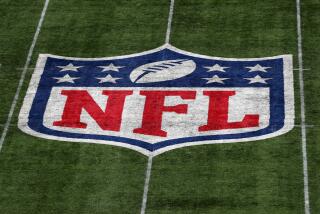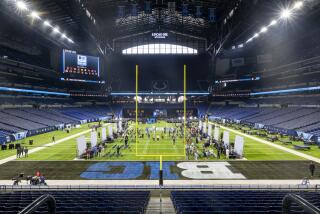Disability Payments Ease Pain
- Share via
He was the greatest player in arguably the greatest NFL game ever played, a giant among the New York Giants and the Baltimore Colts.
Today, Johnny Unitas, the quarterback who led the Colts to victory over the Giants in the 1958 NFL championship game, the first sudden-death contest and the game that catapulted pro football to a new level of public consciousness, struggles to sign autographs. The right arm that enabled Unitas to pass for touchdowns in an NFL-record 47 consecutive games has been permanently damaged.
Yet Unitas, 66 and still living in the Baltimore area, receives nothing from the league that owes him an invaluable debt for its lofty status.
Unfair? Cruel?
Not necessarily.
There are many other former NFL players limping around, the injuries they suffered in their brutal sport leaving them in pain, and, in some cases, in wheelchairs.
And many are cared for under the terms of a pension/disability plan, part of the collective bargaining agreement agreed to by the players and owners in 1993. That plan pays out $2 million a month in retirement/disability benefits, $750,000 in the disability category alone.
But Unitas doesn’t qualify for two reasons: He didn’t apply within 12 years after his retirement and, by the medical guidelines of the plan, he is able to work.
In the league’s early years, former players were on their own. They sacrificed their blood and bones to the cause of winning football games at a salary not sufficient to sustain them year-round, forcing them to have a second job in the off-season.
But those sacrifices earned them nothing but perhaps sympathy when their bodies finally gave out.
After nearly 40 years under those conditions, a pension plan was established in 1959. But in the 1960s only one player, former Los Angeles Ram Gene Brito, received disability benefits. He was suffering from bone cancer, which eventually resulted in the amputation of a leg.
In 1979, there was $33 million in the pension plan. This year, there is $500
million.
Under the terms of the 1993 agreement, players who are totally and permanently disabled will receive $224,000 next
year.
To qualify as permanently disabled, players must have experienced one of the following:
* At least a 50% loss of speech, sight or the use of their neck or back.
* At least a 55% loss of the use of an arm, shoulder, leg or hip, or a loss of that percentage of their hearing.
* At least a 70% loss of the use of an elbow, wrist, hand, foot or ankle.
Players also qualify if the injury is the primary cause of the surgical removal of a vital body organ or part of the central nervous system.
Categories to qualify for medical benefits are: football injuries of both active and non-active players, non-football injuries of active players--as in the case of former Seattle Seahawk Mike Frier, who was paralyzed in an auto accident--and degenerative football injuries.
Some have tried to stretch their claims beyond the guidelines. Walt Sweeney, a former San Diego Charger offensive guard, suffered from substance abuse, a condition he maintained was caused by his involvement in pro football. He won his claim for benefits in a lower court.
Sometimes a player who appears to have retired in relatively good shape actually has enough ailments to serve as a poster boy in a doctor’s office.
Though he does not qualify for disability payments, former quarterback Joe Montana, while appearing to be living a healthy, active post-career life, suffers from an aching knee that makes golf painful, a numb foot that makes walking awkward and occasional blurred vision from too many hits to the head.
But unlike in years past, today’s pro football players are usually able to at least walk, or limp, away with monetary compensation. That doesn’t make up for being unable to lift your child or grandchild, but it does help to at least know those youngsters will have a secure financial future.
*
“Nobody walks away from pro football in one piece.” Miki Yaras-Davis, director of benefits for the NFL Players Assn.
More to Read
Go beyond the scoreboard
Get the latest on L.A.'s teams in the daily Sports Report newsletter.
You may occasionally receive promotional content from the Los Angeles Times.









